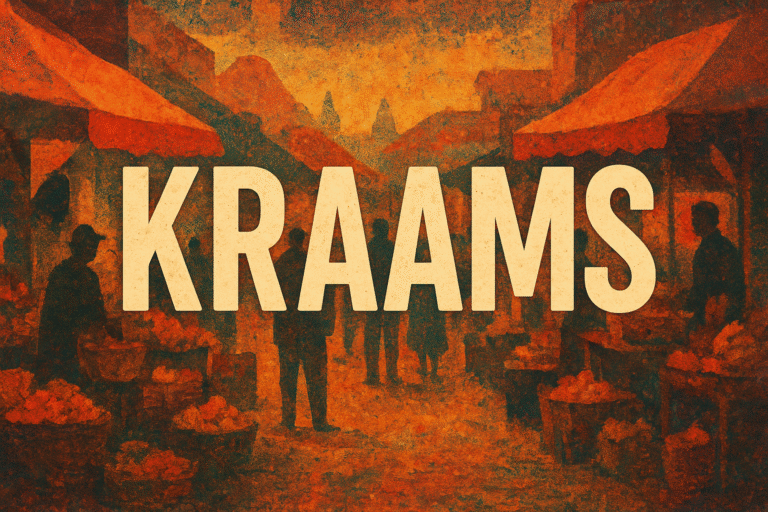Introduction
Every now and then, a word pops up that feels like it holds a secret, a whisper from the past, or maybe even a clue to something bigger than it looks. “Kraams” is one of those intriguing terms. On the surface, it doesn’t instantly reveal its meaning. Is it cultural? Is it symbolic? Or perhaps it’s a modern twist of language finding its way into art, stories, or everyday conversations?
In this article, we’re not just going to scratch the surface. We’ll dig deep into the essence of kraams, look at how it has been interpreted in various contexts, and explore its modern-day relevance. By the end, you’ll not only understand it better but also see how it sparks curiosity and conversation across cultures.
What Does “Kraams” Really Mean?
Language is a living, breathing organism. Words evolve, meanings shift, and sometimes, a single word can carry multiple layers. “Kraams” is one of those words that refuses to be boxed in.
Here are a few interpretations that give it texture:
- Cultural Rooting: Some trace it back to European dialects where it loosely connects to markets or gatherings.
- Symbolic Connections: In folklore, kraams often signify spaces where stories, secrets, or even goods are exchanged.
- Modern Adaptations: Lately, it’s found itself reshaped in artistic communities—used in poetry, music, and creative spaces.
So, does it mean the same thing everywhere? Nope. That’s the beauty of it—it shifts, adapts, and lives differently depending on who’s using it.
Kraams in Culture: A Tapestry of Meaning
To really get kraams, you’ve got to see how cultures wrap it into their fabric.
European Echoes
In Dutch and Germanic regions, kraam often refers to a stall or booth in a market. Imagine vibrant town squares, merchants shouting out their wares, and the lively buzz of trade—that’s kraams in action. It’s more than selling stuff; it’s about human interaction, storytelling, and building connections.
Storytelling Traditions
In folklore, kraams sometimes morph into symbolic places—crossroads where a traveler might encounter fate, luck, or trickery. Doesn’t that sound like something straight out of a fairytale?
Spiritual Interpretations
In some circles, kraams are viewed as metaphorical “spaces of exchange”—where knowledge, spirituality, or energy is passed from one generation to another. It’s less about goods and more about wisdom.
The Modern Face of Kraams
Language evolves with society, and kraams has found itself popping up in unexpected ways.
Creative Arts
- Music & Poetry: Artists borrow kraams as a metaphor for life’s chaos, beauty, and unpredictability.
- Digital Art: Online creators use it as a quirky tag for experimental projects.
Social Media Trends
Let’s face it, words get a new life online. Kraams occasionally pops up as a hashtag, a brand identity, or even in memes. Its mysterious vibe makes it the perfect hook—short, sharp, and intriguing.
Everyday Slang?
In some groups, kraams gets tossed around casually to describe a situation that feels overwhelming or chaotic—“Wow, this place is pure kraams!”
Why Does Kraams Still Matter?
With thousands of new words and phrases flooding our timelines, why does kraams still hold intrigue? Because it’s flexible. It’s a word that can wear multiple hats depending on who’s speaking.
Think about it:
- It can symbolize trade and exchange.
- It can embody chaos and creativity.
- It can spark conversations just by showing up.
In other words, kraams is a linguistic chameleon—shapeshifting its way through culture and modern life.
Life Lessons Hidden in Kraams
Okay, so what can we actually learn from kraams? Turns out, quite a lot.
- Value Exchange Matters
Whether it’s goods in a marketplace or wisdom in a conversation, kraams reminds us that exchange is vital to human connection. - Embrace the Chaos
Markets are noisy, unpredictable, and messy—just like life. Kraams tells us to dive in and find beauty in the bustle. - Stories are Currency
At every kraam, someone has a story to tell. It’s a reminder that storytelling isn’t just entertainment; it’s how we connect and remember.
Kraams in Daily Life: How to Relate?
Ever thought about how you might weave kraams into your own routine? Here are a few ideas:
- Your Work: See your office as a kraam of ideas where everyone brings something unique to the table.
- Friendships: Think of hangouts as kraams where laughter, advice, and support are traded freely.
- Personal Growth: Treat your life as a kraam—constantly exchanging old habits for new experiences.
FAQs About Kraams
Q1: Is kraams a real word or just a made-up concept?
It’s very real, with roots in European languages, but its meaning changes based on context.
Q2: Why do people find kraams intriguing?
Because it feels mysterious, adaptable, and symbolic. It sparks curiosity and conversation.
Q3: Can I use kraams in my writing or speech?
Absolutely! That’s the beauty of it—it’s open-ended, so you can mold it to your own style or purpose.
Q4: Does kraams only mean marketplace?
Nope. While its root ties back to stalls or booths, it’s often used symbolically to represent exchanges of all kinds.
Q5: How do I spot kraams in modern culture?
Look at art, literature, and even hashtags—you’ll see kraams quietly weaving its way into unexpected places.
Conclusion
So, there you have it—kraams, a word that’s more than just letters strung together. It’s a symbol of exchange, a metaphor for chaos, and a reminder of the beauty found in human connection. Whether you stumble upon it in folklore, art, or your own conversations, it invites you to pause and ask: What’s being exchanged here?
At the end of the day, kraams is more than a word. It’s a mirror reflecting the way we connect, share, and live. And maybe, just maybe, it’s a reminder that life itself is one big kraam—colorful, noisy, unpredictable, and worth every moment.

